外研版小学英语一起一年级下册教案.docx
- 格式:docx
- 大小:22.18 KB
- 文档页数:16
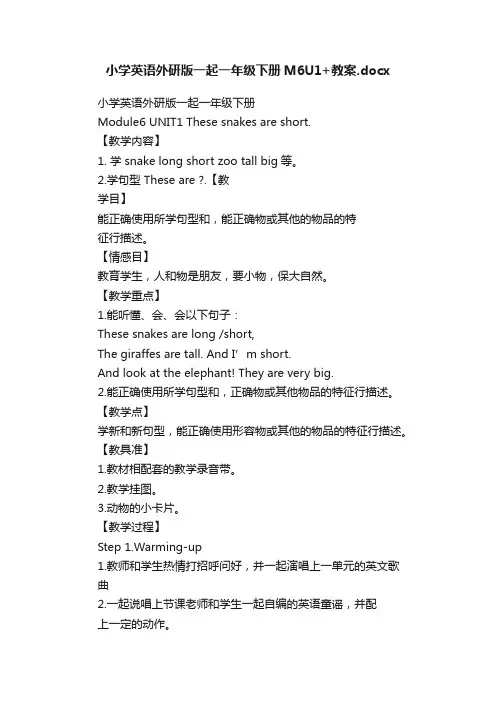
小学英语外研版一起一年级下册M6U1+教案.docx小学英语外研版一起一年级下册Module6 UNIT1 These snakes are short.【教学内容】1. 学 snake long short zoo tall big等。
2.学句型 These are ?.【教学目】能正确使用所学句型和,能正确物或其他的物品的特征行描述。
【情感目】教育学生,人和物是朋友,要小物,保大自然。
【教学重点】1.能听懂、会、会以下句子:These snakes are long /short,The giraffes are tall. And I’m short.And look at the elephant! They are very big.2.能正确使用所学句型和,正确物或其他物品的特征行描述。
【教学点】学新和新句型,能正确使用形容物或其他的物品的特征行描述。
【教具准】1.教材相配套的教学录音带。
2.教学挂图。
3.动物的小卡片。
【教学过程】Step 1.Warming-up1.教师和学生热情打招呼问好,并一起演唱上一单元的英文歌曲2.一起说唱上节课老师和学生一起自编的英语童谣,并配上一定的动作。
Fat fat I am fatThin thin I am thinLittle little I am littleBig big I am big.Step 2.Presentation教师向学生出示two dogs, two cats, two birds, two snakes 的图片。
T:What are they?S: They are_______T:What color are they?S: Green and yellow教师引导学生运用This ___ is____及These___are___句型和学过的单词对照片上的动物进行描述。
最后教师给学生展示“snakes”的图片。
Step 3 .Learn to the text1.同学们,今天Ling 和Amy 一起来到了动物园,让我们一起来看看她们在动物园看到了哪些动物,她们是怎样描述这些动物的。
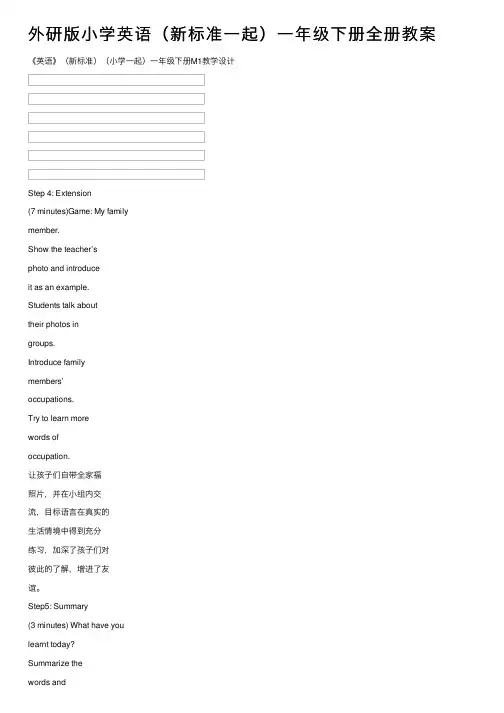
外研版⼩学英语(新标准⼀起)⼀年级下册全册教案《英语》(新标准)(⼩学⼀起)⼀年级下册M1教学设计Step 4: Extension(7 minutes)Game: My familymember.Show the teacher’sphoto and introduceit as an example.Students talk abouttheir photos ingroups.Introduce familymembers’occupations.Try to learn morewords ofoccupation.让孩⼦们⾃带全家福照⽚,并在⼩组内交流,⽬标语⾔在真实的⽣活情境中得到充分练习,加深了孩⼦们对彼此的了解,增进了友谊。
Step5: Summary(3 minutes) What have youlearnt today?Summarize thewords and让孩⼦们通过板书学会⾃⼰梳理⼀节课所学,养成良好的英语学习习惯。
Classroom Assessment 1.Good, I like your voice.2.Perfect.3.Great!…及时评价学习过程,通过⼝头评价,及时反馈学⽣对知识的掌握情况和本课时的⽬标达成情况。
家庭作业:基础性作业:Listen and imitate the text for 5 times.拓展性作业:Talk about family members on the photos with friends.板书设计:Module 1 Unit 1 He’s a doctor.She She’s a girl. teacher= She isHe’s a boy. doctor= He isit as an example. Students talk about their photos in groups. Try to learn more words ofoccupation.⽣活情境中得到充分练习,加深了孩⼦们对彼此的了解,增进了友谊。

外研版(一起)一年级英语下册教案Module 3一、主要语言功能:谈论物品的所属关系;表达某人的职业及其拥有的相关物品。
二、主要学习任务:1. This is her… That is his… Look! Their school bags.2. My mother is a… This is her…My father is a… This is his…3. Is he a…? Yes, he is. / No, he isn’t.4. Are you a…?Yes, I am. / No, I’m not.三、主要词汇:her his their coat dress nurse driver bus (听、说、认读) clown (听、说、)四、课时安排:四课时五、每课时学习任务安排:第一课时:掌握重点句:This is her bag. That is his hat.掌握重点单词:his, her, coat.第二课时:理解课文意思,重点掌握与职业有关的单词。
掌握新单词:clown, their.第三课时:谈论物品与职业的所属关系。
掌握重点句子:Is he a…? Yes, he is. / No, he isn’t.Are you a…? Yes, I am. / No, I’m not.掌握重点单词:nurse, dress, driver, bus.第四课时:掌握句式:My mother is a… This is her….My father is a… This is his…对本模块的内容进行综合复习。
UNIT 1 This is her bag.第一课时教学内容:P11. Unit 1 活动2、活动3。
教学目的:1. 掌握重点句:This is her bag. That is his hat.2. 掌握重点单词:his, her, coat.3. 明确this 与that 的区别。
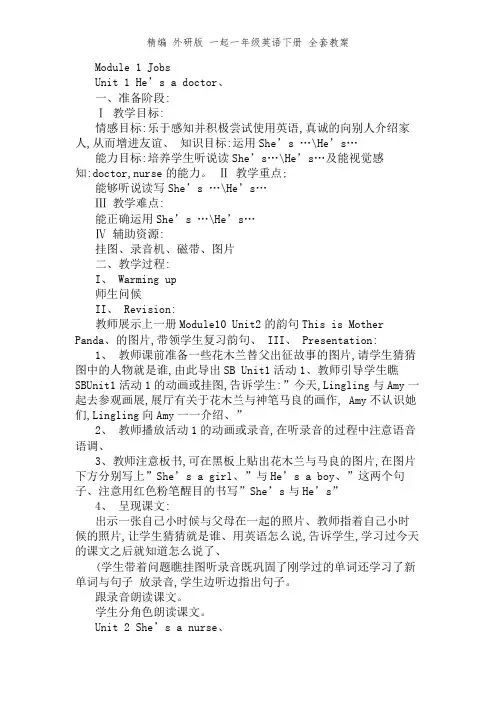
Module 1 JobsUnit 1 He’s a doctor、一、准备阶段:Ⅰ 教学目标:情感目标:乐于感知并积极尝试使用英语,真诚的向别人介绍家人,从而增进友谊、知识目标:运用She’s …\He’s…能力目标:培养学生听说读She’s…\He’s…及能视觉感知:doctor,nurse的能力。
Ⅱ 教学重点;能够听说读写She’s …\He’s…Ⅲ 教学难点:能正确运用She’s …\He’s…Ⅳ 辅助资源:挂图、录音机、磁带、图片二、教学过程:I、 Warming up师生问候II、 Revision:教师展示上一册Module10 Unit2的韵句This is Mother Panda、的图片,带领学生复习韵句、 III、 Presentation:1、教师课前准备一些花木兰替父出征故事的图片,请学生猜猜图中的人物就是谁,由此导出SB Unit1活动1、教师引导学生瞧SBUnit1活动1的动画或挂图,告诉学生:”今天,Lingling与Amy一起去参观画展,展厅有关于花木兰与神笔马良的画作, Amy不认识她们,Lingling向Amy一一介绍、”2、教师播放活动1的动画或录音,在听录音的过程中注意语音语调、3、教师注意板书,可在黑板上贴出花木兰与马良的图片,在图片下方分别写上”She’s a girl、”与He’s a boy、”这两个句子、注意用红色粉笔醒目的书写”She’s与He’s”4、呈现课文:出示一张自己小时候与父母在一起的照片、教师指着自己小时候的照片,让学生猜猜就是谁、用英语怎么说,告诉学生,学习过今天的课文之后就知道怎么说了、(学生带着问题瞧挂图听录音既巩固了刚学过的单词还学习了新单词与句子放录音,学生边听边指出句子。
跟录音朗读课文。
学生分角色朗读课文。
Unit 2 She’s a nurse、一、准备阶段:Ⅰ 教学目标:情感目标:培养学生学习英语的兴趣。
知识目标:运用She’s…\及单词driver ,policeman,pupil、能力目标:运用She’s…\He’s…介绍她人职业、Ⅱ 教学重点:学习句型:She’s…\He’s…掌握单词:driver ,policeman,pupil,Ⅲ 教学难点: 部分学生能初步运用:driver ,policeman,pupil,Ⅳ 辅助资源:挂图、录音机、磁带、图片二、教学过程:I、 Warming up请学生演唱她们喜欢的英文歌曲、II、 Revision:教师请几位学生展示上节课的课后作业,用”This is my father\mother、、”来介绍自己制作的”Family Tree”、教师可以将制作精美的图片收集起来进行展览、III、 Presentation:1、教师播放Unit2活动1的录音或动画,请学生瞧动画或挂图、教师引导学生理解语境:Amy到Lingling 家做客,Lingling 兴奋地拿出一张登有她爸爸照片的报纸给Amy 瞧,并介绍她爸爸的职业、2、再次播放录音或动画,请学生跟读、”driver”就是新单词,教师可展示多张司机的照片\图片或卡通片,带领学生说:”He’s a driver、She’s a driver、”3、呈现课文:教师向学生介绍自己家人的职业,学生可能听不太懂、教师告诉学生:”今天我们要学习如何介绍家人的职业、IV、 Practice:1教师播放活动2的录音,请学生瞧图或者动画,引导学生理解课文语境:Amy到Daming 家做客,Daming拿出影集给Amy瞧,并介绍她的家人、2、教师再次播放录音,学生逐句跟读、3、男女生对话,或者分组练习对话、4、进行瞧图说句子的游戏、V、 Summary:Module 2 LocationUnit 1 Where’s the bird?一、准备阶段:Ⅰ教学目标:情感目标:在小组活动中能与其她同学积极配合与合作、知识目标:学习句型Where’s the bird? It’s in\on\under my hat、能力目标:培养学生识别物品位置的能力。
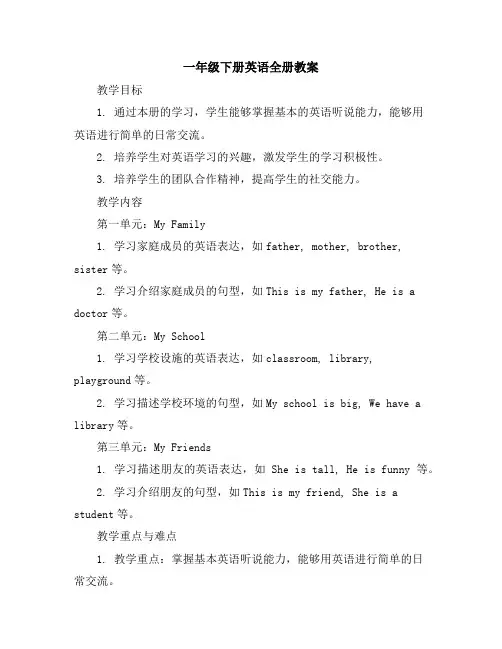
一年级下册英语全册教案教学目标1. 通过本册的学习,学生能够掌握基本的英语听说能力,能够用英语进行简单的日常交流。
2. 培养学生对英语学习的兴趣,激发学生的学习积极性。
3. 培养学生的团队合作精神,提高学生的社交能力。
教学内容第一单元:My Family1. 学习家庭成员的英语表达,如father, mother, brother, sister等。
2. 学习介绍家庭成员的句型,如This is my father, He is a doctor等。
第二单元:My School1. 学习学校设施的英语表达,如classroom, library, playground等。
2. 学习描述学校环境的句型,如My school is big, We have a library等。
第三单元:My Friends1. 学习描述朋友的英语表达,如She is tall, He is funny等。
2. 学习介绍朋友的句型,如This is my friend, She is a student等。
教学重点与难点1. 教学重点:掌握基本英语听说能力,能够用英语进行简单的日常交流。
2. 教学难点:句型的运用,单词的记忆。
教具与学具准备1. 教具:多媒体设备,PPT课件,教学卡片。
2. 学具:英语课本,笔记本,文具。
教学过程1. 导入:通过图片,实物等引导学生进入学习状态。
2. 新课内容学习:通过PPT课件,教学卡片等方式进行新课内容的学习。
3. 练习:通过小组活动,角色扮演等方式进行练习。
板书设计1. 每个单元的主要知识点,如家庭成员的英语表达,介绍家庭成员的句型等。
2. 每个单元的重点句型,如This is my father, He is a doctor等。
作业设计1. 听力练习:听课文录音,完成练习题。
2. 口语练习:模仿课文对话,进行角色扮演。
3. 写作练习:根据课文内容,进行简单的写作练习。
课后反思1. 教师应及时反思教学效果,对教学方法和教学内容进行调整。
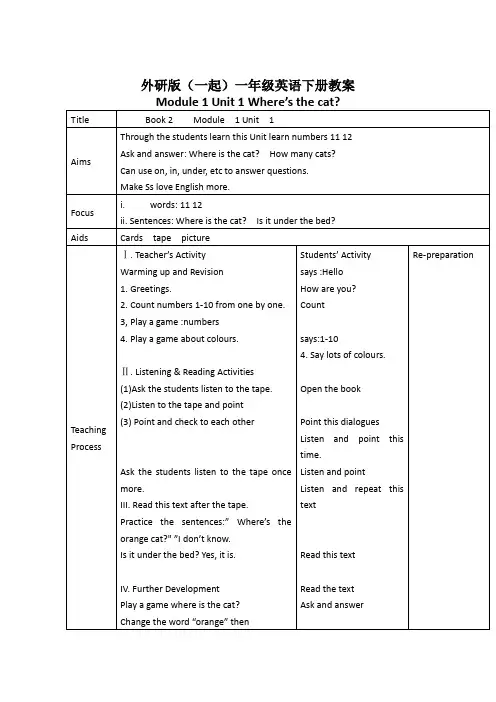
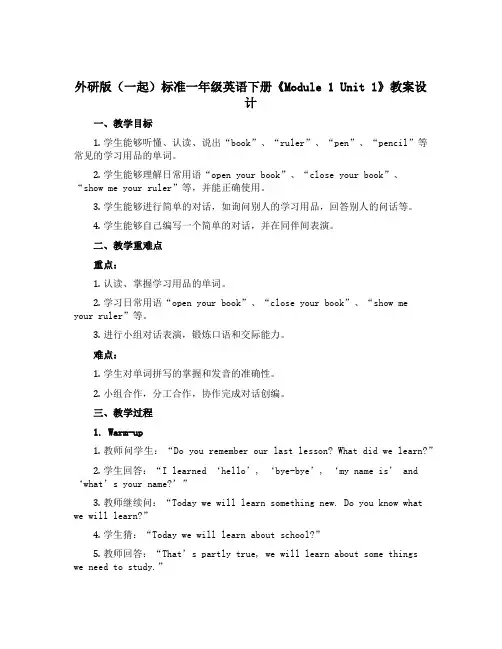
外研版(一起)标准一年级英语下册《Module 1 Unit 1》教案设计一、教学目标1.学生能够听懂、认读、说出“book”、“ruler”、“pen”、“pencil”等常见的学习用品的单词。
2.学生能够理解日常用语“open your book”、“close your book”、“show me your ruler”等,并能正确使用。
3.学生能够进行简单的对话,如询问别人的学习用品,回答别人的问话等。
4.学生能够自己编写一个简单的对话,并在同伴间表演。
二、教学重难点重点:1.认读、掌握学习用品的单词。
2.学习日常用语“open your book”、“close your book”、“show meyour ruler”等。
3.进行小组对话表演,锻炼口语和交际能力。
难点:1.学生对单词拼写的掌握和发音的准确性。
2.小组合作,分工合作,协作完成对话创编。
三、教学过程1. Warm-up1.教师问学生:“Do you remember our last lesson? What did we learn?”2.学生回答:“I learned ‘hello’, ‘bye-bye’, ‘my name is’ and‘what’s your name?’”3.教师继续问:“Today we will learn something new. Do you know what we will learn?”4.学生猜:“Today we will learn about school?”5.教师回答:“That’s partly true, we will learn about some things we need to study.”2. Presentation1.教师出示学习用品图片:“book”、“ruler”、“pen”、“pencil”等,并进行单词发音和掌握方法讲解,让学生跟读单词,并重复发音和手势学习。
![精编外研版(一起)一年级英语下册全套教案[2]](https://uimg.taocdn.com/8cde768648d7c1c709a1459e.webp)
精编外研版(一起)一年级英语下册全套教案(word版可编辑修改)编辑整理:尊敬的读者朋友们:这里是精品文档编辑中心,本文档内容是由我和我的同事精心编辑整理后发布的,发布之前我们对文中内容进行仔细校对,但是难免会有疏漏的地方,但是任然希望(精编外研版(一起)一年级英语下册全套教案(word版可编辑修改))的内容能够给您的工作和学习带来便利。
同时也真诚的希望收到您的建议和反馈,这将是我们进步的源泉,前进的动力。
本文可编辑可修改,如果觉得对您有帮助请收藏以便随时查阅,最后祝您生活愉快业绩进步,以下为精编外研版(一起)一年级英语下册全套教案(word版可编辑修改)的全部内容。
Module 1 JobsUnit 1 He's a doctor.一、准备阶段:Ⅰ 教学目标:情感目标:乐于感知并积极尝试使用英语,真诚的向别人介绍家人,从而增进友谊。
知识目标:运用She’s …\He’s…能力目标:培养学生听说读She’s…\He's…及能视觉感知:doctor,nurse的能力. Ⅱ 教学重点;能够听说读写She's …\He’s…Ⅲ 教学难点:能正确运用She's …\He’s…Ⅳ 辅助资源:挂图、录音机、磁带、图片二、教学过程:I. Warming up师生问候II。
Revision:教师展示上一册Module10 Unit2的韵句This is Mother Panda.的图片,带领学生复习韵句. III. Presentation:1. 教师课前准备一些花木兰替父出征故事的图片,请学生猜猜图中的人物是谁,由此导出SB Unit1活动1.教师引导学生看SBUnit1活动1的动画或挂图,告诉学生:”今天,Lingling和Amy一起去参观画展,展厅有关于花木兰和神笔马良的画作, Amy不认识他们,Lingling向Amy一一介绍."2. 教师播放活动1的动画或录音,在听录音的过程中注意语音语调。
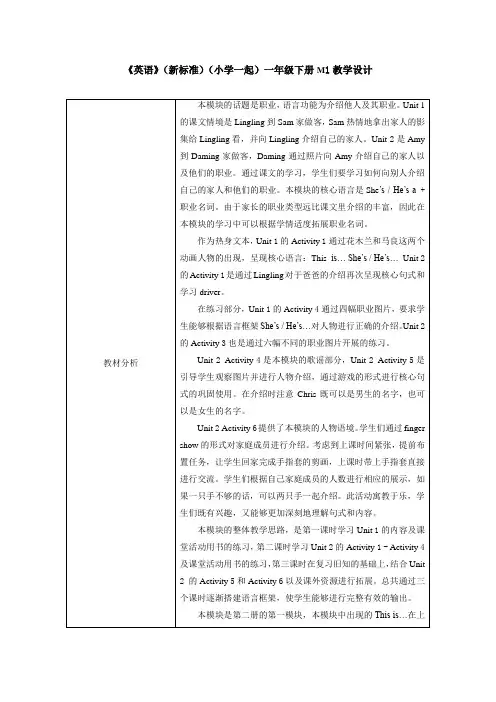
《英语》(新标准)(小学一起)一年级下册M1教学设计Step 4: Extension(7 minutes)Game: My familymember.Show the teacher’sphoto and introduceit as an example.Students talk abouttheir photos ingroups.Introduce familymembers’occupations.Try to learn morewords ofoccupation.让孩子们自带全家福照片,并在小组内交流,目标语言在真实的生活情境中得到充分练习,加深了孩子们对彼此的了解,增进了友谊。
Step5: Summary(3 minutes) What have youlearnt today?Summarize thewords andsentences.让孩子们通过板书学会自己梳理一节课所学,养成良好的英语学习习惯。
Classroom Assessment 1.Good, I like your voice.2.Perfect.3.Great!…及时评价学习过程,通过口头评价,及时反馈学生对知识的掌握情况和本课时的目标达成情况。
家庭作业:基础性作业:Listen and imitate the text for 5 times.拓展性作业:Talk about family members on the photos with friends.板书设计:Module 1 Unit 1 He’s a doctor.She She’s a girl. teacher= She isHe’s a boy. doctor= He isit as an example. Students talk about their photos in groups. Try to learn morewords ofoccupation.生活情境中得到充分练习,加深了孩子们对彼此的了解,增进了友谊。
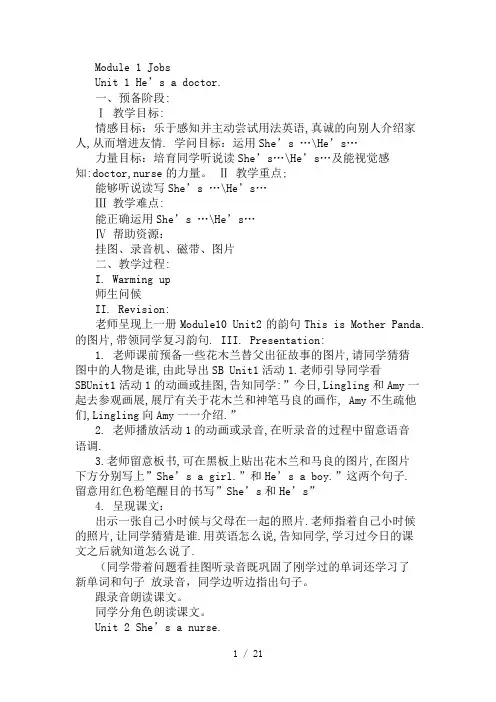
Module 1 JobsUnit 1 He’s a doctor.一、预备阶段:Ⅰ 教学目标:情感目标:乐于感知并主动尝试用法英语,真诚的向别人介绍家人,从而增进友情. 学问目标:运用She’s …\He’s…力量目标:培育同学听说读She’s…\He’s…及能视觉感知:doctor,nurse的力量。
Ⅱ 教学重点;能够听说读写She’s …\He’s…Ⅲ 教学难点:能正确运用She’s …\He’s…Ⅳ 帮助资源:挂图、录音机、磁带、图片二、教学过程:I. Warming up师生问候II. Revision:老师呈现上一册Module10 Unit2的韵句This is Mother Panda.的图片,带领同学复习韵句. III. Presentation:1. 老师课前预备一些花木兰替父出征故事的图片,请同学猜猜图中的人物是谁,由此导出SB Unit1活动1.老师引导同学看SBUnit1活动1的动画或挂图,告知同学:”今日,Lingling和Amy一起去参观画展,展厅有关于花木兰和神笔马良的画作, Amy不生疏他们,Lingling向Amy一一介绍.”2. 老师播放活动1的动画或录音,在听录音的过程中留意语音语调.3.老师留意板书,可在黑板上贴出花木兰和马良的图片,在图片下方分别写上”She’s a girl.”和He’s a boy.”这两个句子.留意用红色粉笔醒目的书写”She’s和He’s”4. 呈现课文:出示一张自己小时候与父母在一起的照片.老师指着自己小时候的照片,让同学猜猜是谁.用英语怎么说,告知同学,学习过今日的课文之后就知道怎么说了.(同学带着问题看挂图听录音既巩固了刚学过的单词还学习了新单词和句子放录音,同学边听边指出句子。
跟录音朗读课文。
同学分角色朗读课文。
Unit 2 She’s a nurse.一、预备阶段:Ⅰ 教学目标:情感目标:培育同学学习英语的爱好。
学问目标:运用She’s…\及单词driver ,policeman,pupil.力量目标:运用She’s…\He’s…介绍他人职业.Ⅱ 教学重点:学习句型:She’s…\He’s…把握单词:driver ,policeman,pupil,Ⅲ 教学难点: 部分同学能初步运用:driver ,policeman,pupil,Ⅳ 帮助资源:挂图、录音机、磁带、图片二、教学过程:I. Warming up请同学演唱他们宠爱的英文歌曲.II. Revision:老师请几位同学呈现上节课的课后作业,用”This is my father\mother..”来介绍自己制作的”Family Tree”.老师可以将制作精致的图片收集起来进行展览.III. Presentation:1.老师播放Unit2活动1的录音或动画,请同学看动画或挂图.老师引导同学理解语境:Amy到Lingling 家做客,Lingling 兴奋地拿出一张登有她爸爸照片的报纸给Amy 看,并介绍她爸爸的职业.2.再次播放录音或动画,请同学跟读.”driver”是新单词,老师可呈现多张司机的照片\图片或卡通片,带领同学说:”He’s a driver. She’s a driver.”3. 呈现课文:老师向同学介绍自己家人的职业,同学可能听不太懂.老师告知同学:”今日我们要学习如何介绍家人的职业.IV. Practice:1老师播放活动2的录音,请同学看图或者动画,引导同学理解课文语境:Amy到Daming 家做客,Daming拿出影集给Amy看,并介绍他的家人.2. 老师再次播放录音,同学逐句跟读.3.男女生对话,或者分组练习对话.4. 进行看图说句子的玩耍.V. Summary:Module 2 LocationUnit 1 Where’s the bird?一、预备阶段:Ⅰ教学目标:情感目标:在小组活动中能与其他同学主动协作和合作.学问目标:学习句型Where’s the bird? It’s in\on\under my hat.力量目标:培育同学识别物品位置的力量。
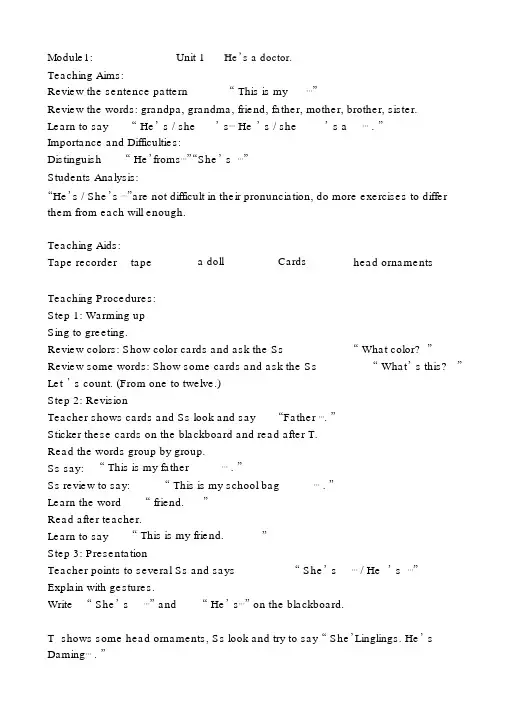
Module1:Unit 1He’s a doctor.Teaching Aims:Review the sentence pattern“ This is my⋯”Review the words: grandpa, grandma, friend, father, mother, brother, sister.Learn to say“ He’ s / she’ s⋯He’ s / she’ s a⋯ .”Importance and Difficulties:Distinguish“ He’froms⋯”“She’ s ⋯”Students Analysis:“He’s / She’s ⋯”are not difficult in their pronunciation, do more exercises to differ them from each will enough.Teaching Aids:Tape recorder tape a doll Cards head ornamentsTeaching Procedures:Step 1: Warming upSing to greeting.Review colors: Show color cards and ask the Ss“ What color? ”Review some words: Show some cards and ask the Ss“ What’ s this? ”Let ’ s count. (From one to twelve.)Step 2: RevisionTeacher shows cards and Ss look and say“Father ⋯. ”Sticker these cards on the blackboard and read after T.Read the words group by group.Ss say:“ This is my father⋯ . ”Ss review to say:“ This is my school bag⋯ . ”Learn the word“ friend.”Read after teacher.Learn to say“ This is my friend.”Step 3: PresentationTeacher points to several Ss and says“ She’ s⋯ / He ’ s ⋯”Explain with gestures.Write“ She’ s⋯” and“ He’ s⋯” on the blackboard.T shows some head ornaments, Ss look and try to say “ She’Linglings. He’ s Daming⋯ . ”Read “ She’ s Lingling. He’ s Daming.⋯” after T.Ask some Ss to go to the front and stand in a line.Ss look and say“ She’ s⋯”/“ He’ s⋯”Step 4: ConsolidationTeacher makes a model.Ss try to introduce his friend like“ She’ s⋯/ He’ s⋯”. Teacher points and says“She’s a pupil.” Or“He’s a pupil.”Ss learn to say.Teaching Notes:Module 1:Unit 2She’s a nurse.Teaching Aims:1.Review the points of the module.2.Learn to introduce a people like She’s⋯/She“’s a nurse. ”3.Do the exercises of the module.Importance and Difficulties:He’ s / She’ s a pupil.Words: doctor, pupil, teacher.The exercises of the module.Students Analysis:We have learnt many words in the module: father, mother, brother, sister, grandpa, grandma, friend, pupil, doctor and so on, so it is necessary to review them intoday’s lesson, and put the words in the sentence patterns: This is my⋯/He’s/she’s⋯ Teaching Aids:Tape recorder a big pencil a doll Cards head ornamentsTeaching Procedures:Step 1: Warming upSing to say hello.Review the chant: Where’ s the pencil?Ss say the chant together.Put a pencil in different place, Ss look and answer teacher’ s question pencil? ”Put a school bag on the desk, ask“Where’s the school bag? ” Ss answer.Put a big pencil in / on / under the school bag, Ss look and say its location.Step 2: RevisionReview the sentence“ Look at the tree.” And“ Look at the window⋯ . ”Review the sentence“ So many birds.” And the sentence pattern“ So ma Review to say“ Let ’ s count.”Count from one to twelve.Look the cards and answer“ Father / mother /⋯” quickly.Introduce those cards like“ This is my brother. /⋯”Look and say “ This is my pencil⋯ . ”Review the chant:She, she, she. She ’s Amy.He, he, he. He’ s Daming.Read the chant after T.Say your classmates’ name. (She’ s⋯ / He ’ s ⋯) Step 3: PresentationTeacher points several Ss and says“ She’ s a pupil. / He Learn the word“ pupil.”Ss read the word.Some Ss stand up,the others look and say“She’s a pupil. / He Look at the head ornaments and say“ She’ s a pupil. / He Teacher shows the card and says“ He’ s a doctor. ”Learn the word“ doctor.”Step 4: Do the exercisesActivity book: Exercise 2 on page 7Exercise 3 on page 9Teaching Notes:’ s a pupil.”’s a pupil. ”’ s a pupil. ”Module2:Unit 1Where’s the bird?Period 1Teaching Aims:Understand the meaning of the text.Review the sentence pattern“ A cat is in/Wheretbox’s.my pen?”Describe the location like“It’s in / on/ under ..”Importance and Difficulties:The sentence pattern:“A cat is in the box.”Try to ask:“ Where’ s the orange cat?”Students Analysis:We have learnt the pattern “Where’s the⋯?”last week, so it is a consolidation of last period, just add some new points: Where’s the orange cat?Teaching Aids:Tape recorder PicturestapeCardsa dollTeaching Procedures:Step 1: Warming upGreeting to Ss with a song.A TPR game: Listen and do.T:“ Stand up! Sit down! Open your book! Point to the window. Point to the doorStep 2: RevisionShow four cards. T:“ What’ s this?” /“ This is⋯”Read the four words in high and low voice.Read fast.T:“ If you know, please stand up and read it fast.”Show the wall chart.Describe the location of the pen or the cat in the wall chart.Step 3: PresentationT points to the wall chart and asks:“ Where’ s the pen?” Ss answer:“Write the two sentences on the blackboard: Where’ s the pen?. It’ s in the Read them after T in correct pronunciation and intonation.Ask several Ss to repeat.Read group by group.Step 4: PracticeSs ask T:“ Where’ s the pen?” T answer.Group 1 ask, group 2 answer from teacher’ s points.Change. Group 2 ask and group 1 answer.Practice with your partner.Show some dialogues.Step 5: PresentationA yellow pen in under the hat.T asks:“ Where’ s the green pen?”⋯ . Ss answer.Write the 2 sentences on the blackboard.Read after T.Ask several Ss repeat it.Read group by group.Step 6: PracticeT points to the picture, Ss ask:“ Where’ s the yellow pen?”⋯T answer Group 1 ask and group 2 answer, then change.Practice with partner.Show your dialogue.Step 7: ConsolidationA game: Look and guess.“ Please look at my mouth, and guess the sentence.”Teaching NotesModule3:Unit1 Where is the orange cat?TeachingAims:1. Review the sentence pattern“Where’s the orange cat?”2. Learn to guess the location of object with under/ in“/ onIs⋯it?”Notes:Importance and Difficulties:Use the sentence:“Is it under/ in / on the bed? to” ask the location.Students Analysis:It is not easy for the kids to use the sentence:“Is itunder / in / on the bed? to” ask the location. Use the same thing to change its location each time will easier to the kids.Teaching Aids:Tape recorder tape a doll book Cards school bag box penTeaching Procedures:Step 1: Warming upSing a hello song to greet with each other.Play a guessing game.“ Please look at my gestures, and then guess the animal I mime.”Step 2: RevisionAnswer teacher’ s question accord to the card.“ What’ s this?” /“ Is it a monster?”Read the four words: doll, bear, bed, and balloon.A game: I hide, you guess.“ Look, I hide a card; please guess what the card is.”Look and answer.(Teacher put some stationery, and asks the location.)Write the four sentences on the blackboard: Where’ s the cat?It ’s in the box.Where’s the orange cat?It ’s under the box.Read after teacher and correct their pronunciation and intonation.Ask several students read them.Read the four sentences group by group.Step 3: Presentation and practiceTeacher hides a school bag, a book, and a box under the table. Then put a pen in one⋯)of them. (in the school bag, on the box, or under the bookSs try to guess the location of the pen.“ Is it⋯?”Write the two sentences on the blackboard:Is it under the bed?Yes, it is.Read after teacher.Ask several students read it.Read fast group by group.Continue to play the game.Step 4: ConsolidationRead the 4 sentences after teacher again.Play a game: Hear and read fast.(Listen to teacher’ s sentence, and then read it fast group by group.)Step 5: EndingSummarize the class.Sing and say goodbye.Teaching Notes:Module3:Unit2How many green birds?Teaching Aims:Learn the numbers: 11 and 12.Understand the sentences“ Look at the tree.” “ So many birds!”and“Importance and Difficulties:The pronunciation of“ eleven and twelve”.The sentence“Look at the tree.”Students Analysis:In fact, most students have learnt the words: eleven and twelve already, but most ofthem didn’tcatch the right pronunciation of the sound /v/, pay more attention here in class.Teaching Aids:Tape recorder tape a doll CardsTeaching Procedures:Step 1: Warming upSing and say hello.Review the chant.Read the chant together with gestures.Review the four words: balloon, bed, bear, and doll.(A game: T writes the four words on the blackboard, and then read three of them; Sssay the word T doesn’ t read.)Step 2: Presentation and practiceA game: Listen and do.(T:“ Point to the ceiling. Point tohet window. Stand up! Open your book. Sit down!Close your book. Look at the door.”)T makes gesture to explain the sentence“ Look at the door.”Continue to play the game.(Look at the teacher. Look at the ceiling. Look at the floor. Look at the windowT shows several cards and asks“What’s this?” (tree)Teach the new word“ tree”.Read and mime a tree.T:“ Look at the tree.”Write the sentence“ Look at the tree.” On the blackboard.Read and make gestures.Stick the wall chart on the blackboard.Get the Ss to look at the big tree.T: “ Look at the tree. So many birds!”Make gesture to explain the phrase“ so many ⋯”.Write“ So many birds!” on the blackboard.Read after T and then read together.T: “ Oh, how many birds? Let’ s count. ”Teach“ Let ’ s count.”Write it on the blackboard.Read and correct their pronunciation.Count the birds in the tree together.“ OK, now, let ’ s count, how many birds? One, two, and three⋯”Teach the number eleven and twelve.T: “ How many birds?” Ss:“ Twelve birds. ”Step 3: ConsolidationRead the sentence on the blackboard again.Fast reaction: Listen to teacher’ s sentence and repeat it fast group by group Teaching Notes:Module 4:Unit 1This is my head.TeachingAims:1.Understand the meaning of the module.2.Learn the three new words: head, mouth, eye.3. Can survey like: This is my head / mouth /⋯Importance and Difficulties:1. The pronunciation of“mouth”.2. Do the survey.StudentsAnalysis:This module is funny, the kids like to show their body. The problem is the three words’pronunciation, like /e/, /ai/ and “th”. Practice more here.Teaching Aids:Tape recorder tapes cardsCD-ROMTeaching Procedures:Step 1: Warming upSing to greeting each other.Sing a song.Step 2: RevisionReview some words:Bus, doctor, dress, nurse, driver, coatA game: I do, you say.Read them fast.Review to say:“ She’ s / He’ s Review to say:“ This is his / her ⋯ . ”⋯ .”Step 3: PresentationT shows a picture of a head.T asks:“ What’ s this?”Ss try to answer. (a head)Learn to say“ head ”.Point your head and read“ head ” in a little game. Read head in a chant.Learn to say“ This is my head.”Learn the word“ mouth ” and“ eye ” in the same way. Learn to say“ This is my mouth / eye.”Step 3: PracticeRead the 3 words again.Fast reaction: I say, you point.I point, you say.T points, Ss say“ This is my head/⋯”Step 5: ConsolidationGet the Ss to say“ This is my pencil. /⋯”Listen to the tape and try to understand the text.Read the text after the tape-recorder.Teaching Notes:Module 4:Unit 2These are your legs.Period 1Teaching Aims:3.Learn a song: Heads, shoulders.Importance and Difficulties:1.The pronunciation of the sentence: “These are ⋯”2.The English song: Heads, shoulders.Students Analysis:“These are ⋯”is a difficult point to the kids, make simples first and then let them find the order of “these are + -s”,it will be a great help.Teaching Aids:Tape recorder tapes cards stationeryTeaching Procedures:Step 1: Warming upGreeting each other.Words game: Ask and answer.Review to say“ This is his / her⋯.”Step 2: RevisionReview these body words in a game: ask and answer.Review to survey“ This is my / your⋯.”Step 3: PresentationT points to an eye and asks: What’ s this?Ss: This is an eye.T points to the other eye and asks: What’ s this?Ss: This is an eye.T asks: How many eyes do you have?Ss: Two eyes.“ These are my eyes.”Ss learn to say“ These are my eyes.”Ss say the sentence one by one.Write the sentence on the blackboard.T points to her legs and says“ These are my legs.Ss point to their legs and say“ These are my legs. Ss learn to say the word“ leg”.T point to ears, Ss look and say“ These are my ears. Step 4: Practice ”””A game: T point, Ss look and say: This is my head. / These are my eyes. ..T shows a pencil to Ss, Ss: This is a pencil.T shows 4 pencils to Ss, Ss: These are pencils.T shows more stationery and asks Ss: What’ s this? / What are these?A game: I show, you say.I say, you show.Step 5: Learn the songCD-ROM: Listen to the song <Head, shoulders.>Turn to page 17 and read the words of the song.Sing follow T sentence by sentence and do the actions.Sing the song together with CD-ROM.Teaching Notes:Module 5:Unit 1They’re cows.Period 1TeachingAims:1.Understand the meaning of the module.2.Learn four new words: cow, pig, chicken and egg.3. Understand“What are they? They are⋯”Importance and Difficulties:1. Try to speak“What are they? They are⋯”2. The pronunciation of the words: chicken and egg.StudentsAnalysis:Animals always the children s favorite,’ but today’s animals are not easy to catch. We can make the words into some chant, so that it will be easier to catch them.Teaching Aids:Tape recorder CD-ROM tapespicturescardswall chartTeaching Procedures:Step 1: Warming upSing the song <Head, shoulders.>Greeting each other.Step 2: RevisionReview words: a game: Ask and answer chantT points, Ss look and say“ This is my head T shows some stationery, Ss look and sayStep 3: PresentationTurn to page 18.Observe the pictures and listen to teacher.Get the Ss to understand the text.Learn the word“ cow” :⋯ . / These are my ears ⋯ . ”“ This is a pencil ⋯ . / These areA. Observe picture 2.B. Learn the new word“cow”.C. Get the Ss count“How many cows?”D. Learn to say“They are cows.”E. Say it group by group.F. T asks: What are they? Ss answer.G. Learn to say“What are they?”H. Say it one bye one.Learn the other new words: pig, chicken, egg. Picture 3: pig---pigsPicture 4: chi ken---chickensPicture 5: egg---eggsWord games: A. ChantB. Left and rightStep 4: PracticePage 19: activity 2.Read after T.Read group by group.Read the conversation one by one. Blackboardwriting:Teaching Notes:Module 5:Unit 2It’s thin.Period 1TeachingAims:Learn the new words.Understand the text.Importance and Difficulties:The new word“ thin”.The meaning of the textStudentsAnalysis:The text is not easy to the kids, actually they cannot express their meaning like this, today’s key points is learn to describe the things, like“It’s thin/ fat/ little/ pink ”etc.Teaching Aids:Tape recorder tapes cards stationeryTeaching Procedures:Step 1: Warming upSing to greeting.Sing a song.Step 2: RevisionWords chant: Ask and answer chantWatch the CAI and review the sentence patterns: What are they? They are cows. Game: T imitates the animal’ s voice; Ss guessthey?“” What areStep 3: PresentationObserve the wall chart of the text.Learn to say: mother pig, father pig⋯Watch the card and learn to say“ baby pig”.Look at the father pig and learn the new word: fat.Look at the mother pig and learn the new word: thin.Count: How many baby pigs? Six.Look at the baby pigs and learn the new words: big, little Read those words and do the actions after T.Watch the card and learn the new word“ pink”. Step 3: PracticeReview the colors.T points, Ss read the words.T says the word, Ss do the actions.T do the actions, Ss says the word.Words chant.Watch the pictures and say:This is a panda. It’ s fat.This is a monkey. It’s thin.This is a baby pig. It’s little.This is a father pig. It’s big. Blackboardwriting:Teaching Notes:Module 6:Unit 1These snacks are short.Period 1TeachingAims:1.Understand the meaning of the module.2.Learn four animal words: snake, giraffe, elephant, lion3. Try to understand and learn“long,tall, short,andshort”.Importance and Difficulties:Understand the 2 meaning of the word“ short”.The pronunciation of “giraffe”.StudentsAnalysis:The four animal words“snake, giraffe, elephant, lion”is not popular as“dog、cat、fish and fish”, there will be more time to read them out. Especially the pronunciation of “giraffe and elephant”.Teaching Aids:Tape recorder CD-ROM tapespicturescardswall chartTeaching Procedures:Step 1: Warming upGreeting each other.Review: cow, pig, chicken, eggStep 2: RevisionReview“ They’ re⋯”Read activity 2 on page 19.Express time: Describe the picture on page 20.(The pig’s family)(The chicken’s family) Step 3: PresentationLingling and Amy went to the zoo today. Learn the word: zooLearn to say: Let’ s go to the zoo. Observe picture one and find the animal. Learn the new word: snakeRead the word after T and correct Ss’Read the word in a little game: High and low voice Learn the new words“ giraffe, elephant, lion Game: Fast reactionGame: I say, you do. / I do, you say.Point and say: They’ re snakes.⋯Look at the picture and try to understandRead those words.Game: I do, you say.T do the actions, Ss say the word.Step 4: EndingRead all the words together.Sing to say goodbye.Blackboardwriting:Teaching Notes:pronunciation.” in the same way.“ long, short, tall”.Module 6:Unit 2They’re little and cute.Period 1TeachingAims:Learn the new words“ cute” and“ scary”.Try to say: The baby lions are cute.The mother lion isn’ t cute.It ’ s scary.Importance and Difficulties:1. Try to introduce the lion’s family.2. The pronunciation of“isn’t”.StudentsAnalysis:“ Cuteand scary”are adjective verbs. We can understand their meanings by our activities easily. The difficult point is their pronunciations.Teaching Aids:Tape recorder tapes cards stationeryTeaching Procedures:Step 1: Warming upSing to greeting each other.Words game: Ask and answer chantStep 2: PresentationT:Amy and Lingling went to the zoo. They are watching the lions.Learn to express: baby lionCount:“ How many baby lions?”Write“ The baby lions” on the blackboard.Read after T.Learn to say:“The baby lions are cute.”Read row by row.Observe the mother lion and learn the new word: scary.Learn to say:“ The mother lion isn’ t cute. It’ s scary.”Correct the pronunciation of“ isn’ t”.Read the sentence team by team.Step 3: PracticeText: Listen to the tape.Understand the meaning of the text.Try to read the text.Read the text after T sentence by sentence.Read the text by themselves.Page 24: Activity 2 Look and say.Blackboard-writing:Teaching Notes:第三册 Module7 Unit1 There is a cat in this tree.一、教材分析:本元是《新准英》(三年起点)第三册第模第一元的内容,根据《小学英新程准》提出的目,其中一个非常重要的目就是要激学生学英的趣,培养他学英的极度,使他初步建立学英的自信心,使他初步具用英行日常交流的能力。
Module 1 JobsUnit 1 He’s a doctor.一、准备阶段:Ⅰ教学目标:情感目标:乐于感知并积极尝试使用英语,真诚的向别人介绍家人,从而增进友谊. 知识目标:运用She’s …\He’s…能力目标:培养学生听说读She’s…\He’s…及能视觉感知:doctor,nurse的能力。
Ⅱ教学重点;能够听说读写She’s …\He’s…Ⅲ教学难点:能正确运用She’s …\He’s…Ⅳ辅助资源:挂图、录音机、磁带、图片二、教学过程:I. Warming up师生问候II. Revision:教师展示上一册Module10 Unit2的韵句This is Mother Panda.的图片,带领学生复习韵句. III. Presentation:1. 教师课前准备一些花木兰替父出征故事的图片,请学生猜猜图中的人物是谁,由此导出SB Unit1活动1.教师引导学生看SBUnit1活动1的动画或挂图,告诉学生:”今天,Lingling和Amy一起去参观画展,展厅有关于花木兰和神笔马良的画作, Amy不认识他们,Lingling向Amy一一介绍.”2. 教师播放活动1的动画或录音,在听录音的过程中注意语音语调.3.教师注意板书,可在黑板上贴出花木兰和马良的图片,在图片下方分别写上”She’s a girl.”和He’s a boy.”这两个句子.注意用红色粉笔醒目的书写”She’s 和He’s”4. 呈现课文:出示一张自己小时候与父母在一起的照片.教师指着自己小时候的照片,让学生猜猜是谁.用英语怎么说,告诉学生,学习过今天的课文之后就知道怎么说了.(学生带着问题看挂图听录音既巩固了刚学过的单词还学习了新单词和句子放录音,学生边听边指出句子。
跟录音朗读课文。
学生分角色朗读课文。
Unit 2 She’s a nurse.一、准备阶段:Ⅰ教学目标:情感目标:培养学生学习英语的兴趣。
知识目标:运用She’s…\及单词driver ,policeman,pupil.能力目标:运用She’s…\He’s…介绍他人职业.Ⅱ教学重点:学习句型:She’s…\He’s…掌握单词:driver ,policeman,pupil,Ⅲ教学难点: 部分学生能初步运用: driver ,policeman,pupil,Ⅳ辅助资源:挂图、录音机、磁带、图片二、教学过程:I. Warming up请学生演唱他们喜欢的英文歌曲.II. Revision:教师请几位学生展示上节课的课后作业,用”This is my father\mother..”来介绍自己制作的”Family Tree”.教师可以将制作精美的图片收集起来进行展览.III. Presentation:1.教师播放Unit2活动1的录音或动画,请学生看动画或挂图.教师引导学生理解语境:Amy到Lingling 家做客,Lingling 兴奋地拿出一张登有她爸爸照片的报纸给Amy 看,并介绍她爸爸的职业.2.再次播放录音或动画,请学生跟读.”driver”是新单词,教师可展示多张司机的照片\图片或卡通片,带领学生说:”He’s a driver. She’s a driver.”3. 呈现课文:教师向学生介绍自己家人的职业,学生可能听不太懂.教师告诉学生:”今天我们要学习如何介绍家人的职业.IV. Practice:1教师播放活动2的录音,请学生看图或者动画,引导学生理解课文语境:Amy到Daming 家做客,Daming拿出影集给Amy看,并介绍他的家人.2. 教师再次播放录音,学生逐句跟读.3.男女生对话,或者分组练习对话.4. 进行看图说句子的游戏.V. Summary:Module 2 LocationUnit 1 Where’s the bird?一、准备阶段:Ⅰ教学目标:情感目标:在小组活动中能与其他同学积极配合和合作.知识目标:学习句型Where’s the bird? It’s in\on\under my hat.能力目标:培养学生识别物品位置的能力。
Module1JobsUnit1He’sadoctor.一、准段:Ⅰ教学目:情感目:于感知并极使用英,真的向人介家人,从而增友.知目:运用She’s⋯He’s⋯能力目:培养学生听She’s⋯He’s⋯及能感知:doctor,nurse的能力。
Ⅱ教学重点;能听写She’s⋯He’s⋯Ⅲ教学点:能正确运用She’s⋯He’s⋯Ⅳ助源:挂、音机、磁、片二、教学程:I.Warmingup生候II.Revision:教展示上一册Module10Unit2 的韵句ThisisMotherPanda.的片,学生复韵句.III.Presentation:教前准一些花木替父出征故事的片,学生猜猜中的人物是,由此出SBUnit1活1.教引学生看SBUnit1活1的画或挂,告学生:〞今天,Lingling和Amy一起去参画展,展有关于花木和神笔良的画作,Amy不他,Lingling向Amy一一介.〞教播放活1的画或音,在听音的程中注意音.教注意板,可在黑板上出花木和良的片,在片下方分写上〞She’sagirl.〞和He’saboy.〞两个句子.注意用色粉笔醒目的写〞She’s和He’s〞呈文:出示一自己小候与父母在一起的照片.教指着自己小候的照片,学生猜猜是.用英怎么,告学生,学今天的文之后就知道怎么了.〔学生着看挂听音既稳固了学的学了新和句子放音,学生听指出句子。
跟音朗文。
学生分角色朗文。
Unit2She’sanurse.一、准段:Ⅰ教学目:情感目:培养学生学英的趣。
知目:运用She’s⋯及driver,policeman,pupil.能力目:运用She’s⋯He’s⋯介他人.Ⅱ教学重点:学句型:She’s⋯He’s⋯掌握:driver,policeman,pupil,Ⅲ教学点: 局部学生能初步运用:driver,policeman,pupil,Ⅳ助源:挂、音机、磁、片二、教学程:I.Warmingup学生演唱他喜的英文歌曲.II.Revision:教几位学生展示上的后作,用〞Thisismymother..〞来介自己制作的〞FamilyTree〞.教可以将制作精美的片收集起来行展.III.Presentation:教播放Unit2活1的音或画,学生看画或挂.教引学生理解境:Amy到Lingling家做客,Lingling地拿出一登有她爸爸照片的Amy看,并介她爸爸的.再次播放音或画,学生跟.〞driver〞是新,教可展示多司机的照片片或卡通片,学生:〞He’sadriver.She ’sadriver.〞呈文:教向学生介自己家人的,学生可能听不太懂.教告学生:〞今天我要学如何介家人的.IV.Practice:1教播放活2的音,学生看或者画,引学生理解文境:Amy到Daming家做客,Daming拿出影集Amy看,并介他的家人.教再次播放音,学生逐句跟.男女生,或者分.行看句子的游.V.Summary:Module2LocationUnit1Where’sthebird?一、准备阶段:Ⅰ教学目标:情感目标:在小组活动中能与其他同学积极配合和合作.知识目标:学习句型Where’sthebird?It’sin\on\undermyhat.能力目标:培养学生识别物品位置的能力。
外研版(一起)标准一年级英语下册《Module 2 Unit 1》教案设计教学目标•能够听、说、认读外形相似的单词:mop、pot、pop、cop、top、hot、stop。
•培养学生的观察能力,提高学生的思维敏捷度。
•培养学生善于动手实践的能力。
•培养学生良好的语言交际能力。
教学重点•学习单词:mop、pot、pop、cop、top、hot、stop。
•学习如何正确朗读并区分近似的单词。
•通过故事的形式,培养学生的想象力和表达能力。
教学难点如何让学生在正确区分近似的单词的同时不混淆与积累新单词。
教学内容词汇学习1.介绍近似的单词:mop、pot、pop、cop、top、hot、stop。
2.学习新单词:big、map、bag、Matt。
故事学习1.讲解故事前,介绍故事里的单词,使学生准确把握故事。
2.分段教授故事,使学生掌握故事框架。
3.分角色讲故事,培养学生朗读和表达的能力。
教学过程词汇学习1.通过图片或物品展示,引导学生认识近似的单词:mop、pot、pop、cop、top、hot、stop。
2.教师朗读新单词并指出音标和词义。
3.学生跟读新单词并判断自己是否跟上音节。
4.学生学习新单词时,可以花费一定时间探究单词的意义和特点。
5.请几个学生跟读新单词,对比发音并提出改进意见。
故事学习1.教师介绍故事前的单词并讲解,鼓励学生注意听每一个单词的发音差别,培养学生的视觉识别能力。
2.分段教授故事,通过问题引导学生思考故事情节,把握故事框架。
3.学生分组表演,加深情节和内涵理解,培养学生表达和合作的能力。
4.教师和学生分别朗读故事,查漏补缺。
教学总结1.形成学生活动策略和探究性学习的习惯。
2.培养学生的听说读写技能,培养学生的创新思维和语言表达能力。
学习体验教师的设计,让我们的英语课堂变得生动、有趣,我们在这样的英语课堂上获得了很多表达和想象的锻炼。
比如,在进行单词学习时,我发现通过老师的讲解和提示,我能够快速地准确读出新的单词,这是通过反复的强化训练后所达到的。
外研版一起一年级英语下册-全套教案Module 1 JobsUnit 1 He’XXX.一、准备阶段:Ⅰ教学目标:情感目标:乐于感知并积极尝试使用英语,真诚的向别人介绍家人,从而增进友谊.知识目标:运用XXX’s…能力目标:培养学生听说读XXX及能视觉感知:doctor,nurse的能力。
Ⅱ教学重点;能够听说读写XXX’s…Ⅲ教学难点:能正确运用XXX’s…Ⅳ辅助资源:挂图、录音机、磁带、图片二、教学过程:I. Warming up师生问候II. Revision:教师展示上一册Module10 Unit2的韵句This XXX的图片,带领学生复韵句. XXX:1.教师课前筹办一些XXX替父出征故事的图片,请学生猜猜图中的人物是谁,由此导出SB Unit1举动1.教师指导学生看SBUnit1举动1的动画或挂图,通知学生:”今天,XXX和XXX一起去参观画展,展厅有关于XXX和XXX的画作, XXX不认识他们,XXX向XXX逐一介绍.”2.教师播放活动1的动画或录音,在听录音的过程中注意语音语调.3.教师注意板书,可在黑板上贴出XXX和XXX的图片,在图片下方分别写上”She’s a girl.”和He’s a boy.”这两个句子.注意用红色粉笔醒目的书写”She’s和He’s”4.呈现课文:出示一张自己小时候与父母在一起的照片.教师指着自己小时候的照片,让学生猜猜是谁.用英语怎么说,告诉学生,研究过今天的课文之后就知道怎么说了.(学生带着问题看挂图听录音既巩固了刚学过的单词还研究了新单词和句子放录音,学生边听边指出句子。
跟录音朗读课文。
学生分角色朗读课文。
Unit 2 She’s a nurse.一、筹办阶段:Ⅰ教学目标:情感目标:培养学生研究英语的兴趣。
常识目标:应用She’s…\及单词driver ,policeman,pupil.能力目标:运用XXX介绍他人职业.Ⅱ教学重点:研究句型:XXX’s…掌握单词:driver ,policeman,pupil,Ⅲ教学难点:部分学生能开端应用:driver ,policeman,pupil,Ⅳ辅助资源:挂图、录音机、磁带、图片二、教学过程:I. Warming up请学生演唱他们喜欢的英文歌曲.II. Revision:教师请几位学生展示上节课的课后作业,用”XXX..”来介绍自己制作的”Family Tree”.教师可以将制作精美的图片收集起来进行展览.XXX:1.教师播放Unit2活动1的录音或动画,请学生看动画或挂图.教师引导学生理解语境:XXX到Lingling家做客,XXX兴奋地拿出一张登有她爸爸照片的报纸给XXX看,并介绍她爸爸的职业.2.再次播放录音或动画,请学生跟读.”driver”是新单词,教师可展示多张司机的照片\图片或卡通片,带领学生说:”XXX.”3.呈现课文:教师向学生介绍本人家人的职业,学生可能听不太懂.教师通知学生:”今天我们要进修如何介绍家人的职业.IV. Practice:1教师播放举动2的灌音,请学生看图或者动画,指导学生了解课文语境:XXX到XXX家做客,XXX拿出XXX给XXX 看,并介绍他的家人.2.教师再次播放录音,学生逐句跟读.3.男女生对话,或者分组练对话.4.进行看图说句子的游戏.V. Summary:Module 2 LocationUnit 1 Where’s the bird?一、准备阶段:Ⅰ教学目标:情感目标:在小组举动中能与其他同学积极配合和协作.知识目标:研究句型Where’s the bird? It’XXX.能力目标:培养学生识别物品位置的能力。
外研版小学英语一起一年级下册教案Teaching Aims:Review the sentence pattern“ This is my⋯”Review the words: grandpa, grandma, friend, father, mother, brother, sister.Learn to say“ He’ s / she’ s⋯He’ s / she’ s a⋯ .”Importance and Difficulties:Distinguish“ He’froms⋯”“She’ s ⋯”Students Analysis:“He’s / She’s⋯”are not difficult in their pronunciation, do more exercises to differ them from each will enough.Teaching Aids:Tape recorder tape a doll Cards head ornamentsTeaching Procedures:Step 1: Warming upSing to greeting.Review colors: Show color cards and ask the Ss“ What color? ”Review some words: Show some cards and ask the Ss“ What’ s this? ”Let ’ s count. (From one to twelve.)Step 2: RevisionTeacher shows cards and Ss look and say“ Father ⋯ . ”Sticker these cards on the blackboard and read after T.Read the words group by group.Ss say:“ This is my father⋯ . ”Ss review to say:“ This is my school bag⋯ . ”Learn the word“ friend.”Read after teacher.Learn to say“ This is my friend.”Step 3: PresentationTeacher points to several Ss and says“ She’ s⋯ / He ’ s ⋯”Explain with gestures.Write“ She’ s⋯” and“ He’ s⋯” on the blackboard.Read the sentence pattern.T shows some head ornaments, Ss look and try to say“ She’ s Lingling. He Daming⋯ . ”Read “ She’ s Lingling. He’ s Daming.⋯” after T.Ask some Ss to go to the front and stand in a line.Ss look and say“ She’ s⋯”/“ He’ s⋯”Step 4: ConsolidationTeacher makes a model.Ss try to introduce his friend like“ She’ s⋯/ He’ s⋯”.Teacher points and says“ She’ s a pupil.” Or“ He’ s a pupil.”Ss learn to say.Teaching Notes:Module 1:Unit 2She’s a nurse.Teaching Aims:1.Review the points of the module.2.Learn to introduce a people like She’s⋯/She“’s a nurse. ”3.Do the exercises of the module.Importance and Difficulties:He’ s / She’ s a pupil.Words: doctor, pupil, teacher.The exercises of the module.Students Analysis:We have learnt many words in the module: father, mother, brother, sister, grandpa, grandma, friend, pupil, doctor and so on, so it is necessary to review them intoday’s lesson, and put the words in the sentence patterns: This is my⋯/He’s/she’s⋯ Teaching Aids:Tape recorder a big pencil a doll Cards head ornamentsTeaching Procedures:Step 1: Warming upSing to say hello.Review the chant: Where’ s the pencil?Ss say the chant together.Put a pencil in different place, Ss look and answer teacher’ s question pencil? ”Put a school bag on the desk, ask“ Where’ s the school bag?” Ss answer. Put a big pencil in / on / under the school bag, Ss look and say its location.Step 2: RevisionReview the sentence“ Look at the tree.” And “ Look at the window⋯ . ”Review the sentence“ So many birds.” And the sentence pattern“ So ma Review to say“ Let ’ s count. ”Count from one to twelve.Look the cards and answer“ Father / mother /⋯” quickly.Introduce those cards like“ This is my brother. /⋯”Look and say “ This is my pencil⋯ . ”Review the chant:She, she, she. She’ s Amy.He, he, he. He ’ s Daming.Read the chant after T.Say your classmates’ name. (She’ s⋯ / He’ s ⋯)Step 3: PresentationTeacher points several Ss and says“She’s a pupil. / He’s a pupil.”Learn the word“ pupil.”Ss read the word.Some Ss stand up, the others look and say“ She’ s a pupil. / He’ s a pu Look at the head ornaments and say“ She’ s a pupil. / He’ s a pupil.”Teacher shows the card and says“ He’ s a doctor. ”Learn the word“ doctor.”Step 4: Do the exercisesActivity book: Exercise 2 on page 7Exercise 3 on page 9Teaching Notes:Module2:Unit 1Where’s the bird?Period 1Teaching Aims:Understand the meaning of the text.Review the sentence pattern“ A cat is in/Wherethebox’s. my pen?”Describe the location like“It’s in / on/ under ..”Importance and Difficulties:The sentence pattern:“A cat is in the box.”Try to ask:“ Where’ s the orange cat?”Students Analysis:We have learnt the pattern“Where’s the⋯?”last week, so it is a consolidation of last period, just add some new points: Where’s the orange cat?Teaching Aids:Tape recorder tape a dollPictures CardsTeaching Procedures:Step 1: Warming upGreeting to Ss with a song.A TPR game: Listen and do.T:“ Stand up! Sit down! Open your book! Point to the window. Point to the door Step 2: RevisionShow four cards. T:“What’s this?” /“This is⋯”Read the four words in high and low voice.Read fast.T:“ If you know, please stand up and read it fast.”Show the wall chart.Describe the location of the pen or the cat in the wall chart.Step 3: PresentationT points to the wall chart and asks:“ Where’ s the pen?” Ss answer: Write the two sentences on the blackboard: Where’ s the pen? It’ s in the Read them after T in correct pronunciation and intonation.Ask several Ss to repeat.Read group by group.Step 4: PracticeSs ask T:“ Where’ s the pen?” T answer.Group 1 ask, group 2 answer from teacher’ s points.Change. Group 2 ask and group 1 answer.Practice with your partner.Show some dialogues.Step 5: PresentationT draws 3 pictures on the blackboard: A red pen is in the hat.A green pen is on the hat.A yellow pen in under the hat.T asks:“ Where’ s the green pen?”⋯ . Ss answer.Write the 2 sentences on the blackboard.Read after T.Ask several Ss repeat it.Read group by group.Step 6: PracticeT points to the picture, Ss ask:“ Where’ s the yellow pen?”⋯ T answer Group 1 ask and group 2 answer, then change.Practice with partner.Show your dialogue.Step 7: ConsolidationA game: Look and guess.“ Please look at my mouth, and guess the sentence.”Teaching NotesModule3:Unit1 Where is the orange cat?TeachingAims:1. Review the sentence pattern“Where’s the orange cat?”2. Learn to guess the location of object with t under/ in“/ onIs⋯i?”Notes:Importance and Difficulties:Use the sentence:“Is it under/ in / on the bed? to” ask the location.Students Analysis:It is not easy for the kids to use the sentence:“Is it under/ in / on the bed? to”ask the location. Use the same thing to change its location each time will easier to the kids.Teaching Aids:Tape recorder tape a doll book Cards school bag box penTeaching Procedures:Step 1: Warming upSing a hello song to greet with each other.Play a guessing game.“ Please look at my gestures, and then guess the animal I mime.”Step 2: RevisionAnswer teacher’ s question accord to the card.“ What’ s this?” /“ Is it a monster?”Read the four words: doll, bear, bed, and balloon.A game: I hide, you guess.“ Look, I hide a card; please guess what the card is.”Look and answer.(Teacher put some stationery, and asks the location.)Write the four sentences on the blackboard: Where’ s the cat?It ’s in the box.Where’s the orange cat?It ’s undere thbox.Read after teacher and correct their pronunciation and intonation.Ask several students read them.Read the four sentences group by group.Step 3: Presentation and practiceTeacher hides a school bag, a book, and a box under the table. Then put a pen in one of them. (in the school bag, on the box, or under the book⋯)Ss try to guess the location of the pen.“ Is it⋯?”Write the two sentences on the blackboard:Is it under the bed?Yes, it is.Read after teacher.Ask several students read it.Read fast group by group.Continue to play the game.Step 4: ConsolidationRead the 4 sentences after teacher again.Play a game: Hear and read fast.(Listen to teacher’ s sentence, and then read it fast group by group.)Step 5: EndingSummarize the class.Sing and say goodbye.Teaching Notes:Module3:Unit2 How many green birds?Teaching Aims:Learn the numbers: 11 and 12.Understand the sentences“ Look at the tree.” “ So many birds!” and“Importance and Difficulties:The pronunciation of“ eleven and twelve”.The sentence“Look at the tree.”Students Analysis:In fact, most students have learnt the words: eleven and twelve already, but most ofthem didn’tcatch the right pronunciation of the sound /v/, pay more attention here in class.Teaching Aids:Tape recorder tape a doll CardsTeaching Procedures:Step 1: Warming upSing and say hello.Review the chant.Read the chant together with gestures.Review the four words: balloon, bed, bear, and doll.(A game: T writes the four words on the blackboard, and then read three of them; Ss say the word T doesn’ t read.)Step 2: Presentation and practiceA game: Listen and do.(T:“ Point to the ceiling. Point to the window. Stand! Openup your book. Sit down! Close your book. Look at the door.”)T makes gesture to explain the sentence“ Look at the door.”Continue to play the game.(Look at the teacher. Look at the ceiling. Look at the floor. Look at the windowT shows several cards and asks“ What’ s this? ” (tree)Teach the new word“ tree”.Read and mime a tree.T:“ Look at the tree.” Get the Ss to look at the tree card.Write the sentence“ Look at the tree.” On the blackboard.Read and make gestures.Stick the wall chart on the blackboard.Get the Ss to look at the big tree.T: “ Look at the tree. So many birds!”Make gesture to explain the phrase“ so many ⋯”.Write“ So many birds! ” on the blackboard.Read after T and then read together.T:“ Oh, how many birds? Let’ s count. ”Teach“ Let ’ s count.”Write it on the blackboard.Read and correct their pronunciation.Count the birds in the tree together.“ OK, now, let ’ s count, how many birds? One, two, and three⋯”Teach the number eleven and twelve.T:“ How many birds?” Ss:“ Twelve birds. ”Step 3: ConsolidationRead the sentence on the blackboard again.Fast reaction: Listen to teacher’ s sentence and repeat it fast group by group Teaching Notes:Module 4:Unit 1 This is my head.TeachingAims:1.Understand the meaning of the module.2.Learn the three new words: head, mouth, eye.3. Can survey like: This is my head / mouth /⋯Importance and Difficulties:1. The pronunciation of“mouth”.2. Do the survey.StudentsAnalysis:This module is funny, the kids like to show their body. The problem is the three words’pronunciation, like /e/, /ai/ and “th”.Practice more here.Teaching Aids:Tape recorder tapes cardsCD-ROMTeaching Procedures:Step 1: Warming upSing to greeting each other.Sing a song.Step 2: RevisionReview some words:Bus, doctor, dress, nurse, driver, coatA game: I do, you say.Read them fast.Review to say:“ She’ s / He’ s ⋯ . ”Review to say:“ This is his / her⋯ . ”Step 3: PresentationT shows a picture of a head.T asks: “ What’ s this?”Ss try to answer. (a head)Learn to say“ head ”.Point your head and read“ head ” in a little game. Read head in a chant.Learn to say“ This is my head.”Learn the word“ mouth ” and“ eye ” in the same way. Learn to say“ This is my mouth / eye.”Step 3: PracticeRead the 3 words again.Fast reaction: I say, you point.I point, you say.T points, Ss say“ This is my head/⋯”Step 5: ConsolidationGet the Ss to say“ This is my pencil. /⋯”Listen to the tape and try to understand the text.Read the text after the tape-recorder.Teaching Notes:Module 4:Unit 2These are your legs.Period 1Teaching Aims:Understand and try to say the sentence:“These are ⋯”Review the words and learn a new body word: leg.3. Learn a song: Heads, shoulders.Importance and Difficulties:1.The pronunciation of the sentence:“These are ⋯”2.The English song: Heads, shoulders.Students Analysis:“These are⋯”is a difficult point to the kids, make simples first and then let them find the order of “these are + -s”, it will be a great help.Teaching Aids:Tape recorder tapes cardsstationeryTeaching Procedures:Step 1: Warming upGreeting each other.Words game: Ask and answer.Review to say“ This is his / her⋯.”Step 2: RevisionReview these body words in a game: ask and answer.Review to survey“ This is my / your⋯.”Step 3: PresentationT points to an eye and asks: What’ s this?Ss: This is an eye.T points to the other eye and asks: What’ s this?Ss: This is an eye.T asks: How many eyes do you have?Ss: Two eyes.T points to her eyes and say“ These are my eyes.”Ss learn to say“ Thesemyeyesare.”Ss say the sentence one by one.Write the sentence on the blackboard.T points to her legs and says“ These are my legs.”Ss point to their legs and say“ These are my legs.”Ss learn to say the word“ leg”.T point to ears, Ss look and say“ These are my ears.”Step 4: PracticeA game: T point, Ss look and say: This is my head. / These are my eyes. .. T shows a pencil to Ss, Ss: This is a pencil.T shows 4 pencils to Ss, Ss: These are pencils.T shows more stationery and asks Ss: What’ sarethis?these?/WhatA game: I show, you say.I say, you show.Step 5: Learn the songCD-ROM: Listen to the song <Head, shoulders.>Turn to page 17 and read the words of the song.Sing follow T sentence by sentence and do the actions.Sing the song together with CD-ROM.Teaching Notes:Module 5:Unit 1 They’re cows.Period 1TeachingAims:1.Understand the meaning of the module.2.Learn four new words: cow, pig, chicken and egg.3. Understand“What are they? They are⋯”Importance and Difficulties:1. Try to speak“What are they? They are⋯”。